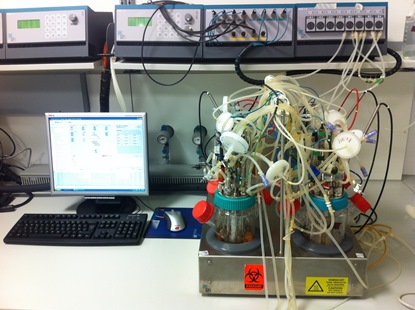Understanding and controlling the expression of recombinant oligomeric immunoglobulins
SUPERVISOR: RENATE KUNERT
Background.
The highly complex IgM proteins are characterized by a heterodimeric μ−kappa⁄lambda heteropentamer linked by the joining chain. Comparably, IgAs are defined by heterodimers. Complex proteins such as IgM and IgA are susceptible to misfolding during maturation, aggregation and degradation events because of many factors including their intrinsic structure, the cell’s biology and even the physico-chemical environment of the culture broth. The scientific challenge is to define biological and technological conditions enabling the release of functional oligomeric proteins into the culture supernatant (Mader et al., 2013). To address this issue, we expressed human IgM and IgA molecules with different specificities (Wolbank et al., 2003; Kunert et al., 2004). Remarkably, we found that varying IgM oligomerization levels (monomers up to naturally occurring pentamers) were driven by the variable region of the antibody (Chromikova et al., 2014). In another example, we investigated two recombinant cell lines expressing IgAs with different variable regions (Reinhart et al., 2012) and found major differences in quantity and quality of expressed proteins despite using the same host cell line, vector system and immunoglobulin alpha-chains. In one case we were able to ascribe the formation of IgA aggregates to environmental conditions (i.e. the culture supernatant), since the intracellularly detected protein was of dimeric structure (Reinhart et al., 2014). The second cell line contained notable amounts of intracellularly misassembled heavy chains and non-secreted light chain aggregates. Preliminary investigations of recombinant cells for ER stress factors and cell cycle related proteins could not elucidate the bottlenecks of proper formation of such complex proteins. This project will systematically investigate environmental factors as well as the cell’s biology to identify their influence on assembly and oligomerization of complex immunoglobulins and ultimately the secretion efficiency.
Aims and methods.
Clones recombinantly expressing different oligomeric immunoglobulins, both IgA and IgM, have previously been established for basic cellular and protein characterization, and these will be used as the starting point for this project, since they differ significantly in their ability to produce and secrete correctly folded proteins. Environmental cultivation conditions will be analysed on a DASGIP parallel bioreactor system under various process relevant parameters (e.g. temperature, pH, pO2, osmotic pressure). Furthermore, several process modes will be applied to compare the performance of batch versus fed-batch, and continuous versus perfusion culture. This will help to understand the effect of process parameters and whether an extended retention time of cells in the bioreactor influences product quality or the formation of aggregates. With this information cells harvested at defined time points will be used for proteomics (ALTMANN, BARRON) and phosphoproteomics analyses.

Raw data will be analysed by bioinformatic methods (ZANGHELLINI, CLARK) with different data-mining approaches. Identified up- or down-regulated proteins will be evaluated by data-base screening as well as experimentally on the protein and transcript level. This combination of experimental and theoretical studies should make possible the elucidation of bottlenecks for protein maturation and assembly in mammalian cells.
The secreted proteins will be purified by affinity chromatography and studied by different spectroscopic and calorimetric techniques (OBINGER) as well as SAXS (MADL) and atomic force microscopy (SCHÄFFER). This will allow us to draw conclusions about the protein’s structural integrity, conformational stability and efficiency of maturation. Analysis of lysed cells will give information where or why protein degradation or aggregation occurs.
Chromikova, V., Mader, A., Steinfellner, W., Kunert, R. (2014) Evaluating the bottlenecks of recombinant IgM production in mammalian cells. Cytotechnology, in press
Kunert, R., Wolbank, S., Stiegler, G., Weik, R., Katinger, H. (2004) Characterization of molecular features, antigen-binding, and in vitro properties of IgG and IgM variants of 4E10, an anti-HIV type 1 neutralizing monoclonal antibody. AIDS Res. Hum. Retrov. 20, 755-762
Mader, A., Chromikova, V., Kunert, R. (2013) Recombinant IgM expression in mammalian cells: A target protein challenging biotechnological production. Adv. Biosc. Biotechnol. 4, 38-43
Reinhart, D., Weik, R., Kunert, R. (2012) Recombinant IgA production: Single step affinity purification using camelid ligands and product characterization. J. Immunol. Meth. 378, 95-101
Reinhart, D., Sommeregger, W., Debreczeny, M., Gludovacz, E., Kunert, R. (2014) In search of expression bottlenecks in recombinant CHO cell lines—a case study. Appl. Microbiol. Biotechnol., in press
Wolbank, S., Kunert, R., Stiegler, G., Katinger, H. (2003) Characterization of human class-switched polymeric (immunoglobulin M [IgM] and IgA) anti-human immunodeficiency virus type 1 antibodies 2F5 and 2G12. J. Virol. 77, 4095-4103
